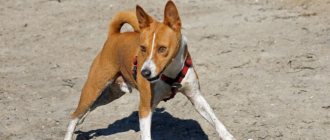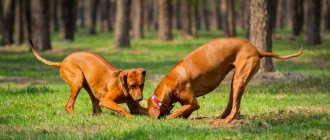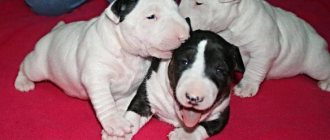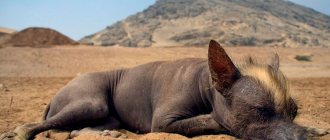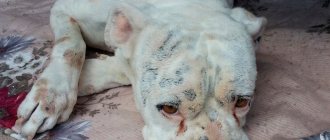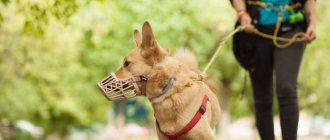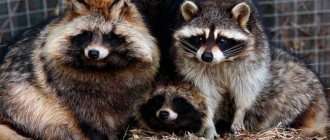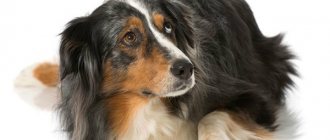It all started with man's desire to explore space. To do this, scientists needed to conduct various experiments, experiments, and studies. All of them were aimed at accurately determining how vibrations, overloads and changes in gravity affect a living organism. At the first stages, it was strictly forbidden to conduct such studies on humans.
Why dogs?
For experiments and research, scientists needed highly organized animals, and these were monkeys and dogs.
At first, scientists chose monkeys, but it turned out to be almost impossible to work with them. As soon as research began, the monkeys showed aggression. They were under constant stress, did not respond to training, and did not tolerate stress well. And then scientists realized that monkeys have nothing to do in space.
For the experiments, a stable psychological state was extremely important, because the animal had to be equipped with many sensors. The only suitable creature was a dog.
Belka and Strelka
Belka, a white mongrel dog, was the leader of the team, the most active and sociable. During training she showed the best results, was among the first to approach the bowl of food, and was the first to learn to bark if something went wrong. Strelka was a light-colored mongrel with brown spots; her character was timid and a little reserved, but friendly. The future tailed cosmonauts were about two and a half years old. It is interesting that at first Belka and Strelka had different names - Albina and Marquise. But the Commander-in-Chief of the Strategic Missile Forces, Mitrofan Nedelin, demanded that the names of the dogs be changed from foreign to Russian. That's how they became Belka and Strelka.
So, on August 19, 1960, two dogs set off into the unknown... The flight lasted more than 25 hours, during which time the ship made 17 complete orbits around the Earth.
Of course, Belka and Strelka quickly became famous. A few months after the flight, Strelka became a mother. One of the six puppies, a “girl” named Pushinka, was given by the then head of the government of our country Nikita Khrushchev to the wife of US President John Kennedy, Jacqueline, and their daughter Caroline.
The mongrel is a breed that has gone down in history
Not every dog was suitable for testing. The cabin in the test rocket was very small - only a dog weighing up to 6 kg and no more than 35 cm tall could fit in. After conducting several tests, scientists determined that the smartest and smartest one was a yard dog without a breed. Moreover, they were already hardened by life, so they should have been able to endure stress more easily.
Then scientists began to select mongrels. They were settled in research centers. We tried to provide them with an ideal life - we fed them well, pampered them with treats, played, and walked. Thus, four-legged animals became real members of the scientific team. Chief rocket designer - S.P. Korolev loved them very much, so he tried to minimize the negative consequences of the experiments. However, it was not without losses.
Photogenic
The mongrel was chosen for the final flight not only based on its physical parameters, the BBC Russian service reports.
For the flight, “cosmonauts” were needed up to 6-7 kg, with a height at the withers of up to 35 cm. Appearance played a major role. The fact is that white dogs were more suitable for photo and video equipment. There was no point in choosing among the thoroughbreds - they were too picky to fly in a satellite. My gaze fell on the female homeless people - they were calmer, more obedient.
Laika had serious competitors - after training in pressure chambers, centrifuges and vibration stands, only 10 dogs remained. And all but one were unsuitable in one way or another. Some were expecting offspring, some had crooked paws. Laika was the only one left who was suitable for the flight and looked good in the frame.
On the first flight
In the first flights, the rockets reached the upper layers of the atmosphere, and then the part where the passengers were was separated and returned to the ground with the help of parachutes.
So on July 22, 1951, Gypsy and Desik flew for the first time. When the rocket with the brave dogs reached an altitude of 100 km, the compartment with passengers became detached and began to fall quickly. But the dogs managed to survive thanks to parachutes that opened 7 km from the ground. Thus, the first suborbital flight in human history lasted only 20 minutes.
The gypsy did not rise in height again, but Desik had one more flight - together with the dog Fox. Unfortunately, it ended tragically - the parachute did not work, and the compartment with the animals crashed on the ground.
After this, experimental takeoffs to the upper atmosphere continued. The next victims of the heights were the furry cosmonauts Chizhik and Mishka. Their first trip was successful, but on August 28, their second flight became their last.
Tailed understudies
Belka and Strelka became widely known only because they became the first dog carriage to return safely to Earth. You can find a lot of information about astronaut dogs on the Internet. Let's take a look, for example, at Wikipedia. This Internet encyclopedia states that Belka and Strelka were stand-ins for the dogs Chaika and Lisichka, who died in the crash on the Sputnik 5 spacecraft during an unsuccessful launch on July 28, 1960 - three weeks before the flight of Belka and Strelka. At the 19th second of flight, the launch vehicle fell to the ground and exploded...
But space research had to be continued. And so they began to prepare Belka and Strelka for a flight on the same ship. Ordinary mongrels, who, during special training, best adapted to conditions similar to being in a space rocket.
Using animals as an example, scientists wanted to trace how the state of weightlessness, overload and other space conditions would affect living organisms. In general, the first group of four-legged cosmonauts began training back in 1951. Only yard dogs were recruited into it - according to doctors, these were the dogs that would be able to fight for survival and were unpretentious in food and living conditions. The dogs had to be friendly, patient and sociable.
The main part of the dogs' preparation for flight took place at the production base of the Institute of Medical and Biological Problems in Moscow. For several months, future four-legged cosmonauts were accustomed to long-term stays in small rooms in conditions of prolonged loneliness and noise. The dogs had to get used to eating special jelly-like food from feeding machines, wearing clothes and using a “space toilet.” To solve this delicate problem, mostly female dogs were selected to be cosmonauts, because it was easier to design a “toilet” device for them.
Light-colored dogs were specially selected for flights because they were easier to monitor on monitor screens. There was one more requirement: the dogs had to look attractive in case they were presented to journalists...
In total, from July 1951 to September 1962, 29 dog flights took place into the stratosphere to an altitude of 100-150 kilometers. Eight "dog crews" died due to failure of landing and life support systems.
Expanding horizons
Gradually, scientists have perfected a way to return furry astronauts back to earth. Instead of descending in a special compartment, passengers were now in a personal space suit. In 1954, Ryzhik and Lisa-2 first tried the new method, and everything went well.
For three years, researchers continued to conduct flights to altitudes of up to 100 km. But since 1957 they moved to a new level - orbital flights. This marked the beginning of the space age.
In October 1957, an event of global significance occurred - the first Earth satellite was launched into space. And a month later, the world was shocked by an even more grandiose event - dogs in space.
Stage two - scientific research
A total of 29 dog flights have taken place since July 1951. Of these, 8 ended tragically. Let's talk about some of the four-legged heroes.
Fox and Bulba
On February 5, 1955, the start took place, but it was unsuccessful, the dogs died.
Rita and Linda
The rocket launched on June 25, 1955. Rita died, Linda returned safely to Earth.
Baby and Button
November 4, 1955. The baby was ejected at an altitude of 90 meters, but the capsule was carried away by the wind and was found only on the third day. The dog survived and waited in the capsule.
Baby and Milda
May 31, 1956. The flight was successful.
Kozyavka and Albina
Two flights in a row on June 7 and 14, 1956. Both successful, the dogs returned home.
Red and Joyna
They launched on May 24, 1957, but both died due to cabin depressurization.
Squirrel and Fashionista
August 25, 1957. The flight was successful, Belka was under anesthesia.
Palm and Fluff
Launched February 21, 1958. Both dogs died due to cabin depressurization.
Nipper and Palm
Flew twice on August 2 and 13, 1958. Subsequently, Kusachka was given another nickname - Brave. We landed successfully.
Motley and Belyanka
On August 27, 1958, they rose to a height of 453 km. After heavy overload, the dogs returned very tired, but healthy.
Brave and Snowflake
July 2, 1959. The rabbit Marfushka was also sent flying with the dogs. The flight ended safely.
Legendary Laika
The most outstanding mongrel in history was destined to be a friendly dog named Laika. She became the first living creature to travel into outer space.
The dog was one of the favorites in the team of scientists. However, science treated her extremely cruelly.
In November 1957, the leadership of the USSR gave the order to launch a space rocket with a mongrel on board. At the same time, the device was significantly unfinished - it did not have a system for returning the passenger back. So, the legendary Laika went into space without a chance to return. This decision was very difficult for the team of scientists.
The dog was seen off with all honors. It is known that the satellite with Laika on board completed approximately two and a half thousand revolutions around the Earth, and then burned up in dense atmospheric layers.
For a long time, the Soviet Union hid the real cause of Laika’s death. According to the official version, she did not die in flight. She was euthanized after returning to Earth. However, such a statement provoked a wave of indignation not only among citizens of the Soviet Union, but also abroad. All over the world, protests began to be held in support of animals. Some Western social activists even proposed sending not a dog into space, but Khrushchev.
Laika still wants to go home: the honest story of the first astronaut dogs
The dog Laika, the first living creature to orbit the Earth, is our national hero. Her brave and tragic Sputnik 2 mission, where the dog became an unwitting pioneer of the Soviet space program more than 57 years ago, is stuck in our collective consciousness. Her story formed the basis of films and songs, and was immortalized in monuments and souvenirs. Here is the honest story of the first astronaut dogs in the world.
Laika is not the only astronaut dog to die during the Soviet space program; more than a dozen other dogs had lost their lives before her. However, during the space race, fueled by the Cold War, NASA in the United States sacrificed several monkeys, paving the way for people with their bones. However, several Soviet space dogs survived and returned to relatively normal lives. Belka and Strelka, who went into space after Laika, landed successfully and became real living legends in the USSR. Laika, Belka, Strelka and other popular cosmonaut dogs symbolized the heroism of the Soviet Union: ordinary animals laid down their lives for the sake of the country's scientific achievements. Everything from stamps and envelopes to children's toys, cigarette packs and candy jars was full of images of these furry icons.
Damon Murray, co-founder of FUEL Design and Publishing in London, decided to create a book about the achievements of Soviet cosmonaut dogs. He collected the images with the help of Olesya Turkina, a senior researcher at the Russian Museum, wrote the text and sent it to his business partner Stephen Sorrell for publishing. The result was a monumental work about Soviet cosmonauts. We will share excerpts and images with you in this article. Questions posed by Collectors Weekly were answered by Damon Murray himself.
How did Soviet ideology influence the USSR space program?
Ideologically, socialism could not fail in any form; for this reason, the Soviet space program was kept tightly under wraps. It was extremely important to keep technological progress secret: both the USSR and the USA tried to hide from each other any events that were being prepared in secret, to “surprise” each other. In fact, this became known as the “space race.”
Flights with dogs were supposed to determine the effect of space on living organisms. Until then, no living creature had experienced either taking off into space and landing on Earth, or weightlessness. All this was carefully checked and studied by scientists of the Soviet space program, they had to determine whether space flights were safe for humans.
Why did you choose dogs and not cats or monkeys?
Dogs have historically been experimental animals in the USSR. Ivan Petrovich Pavlov studied the system of reflexes using them and achieved brilliant results. Monkeys were considered more similar to humans in many respects. Dr. Oleg Gazenko, one of the chief scientists of the space program, even visited the circus to observe the famous Capellini monkeys; in fact, he convinced Gazenko that monkeys were very problematic creatures. They needed intensive training and numerous vaccinations, and were emotionally unstable. (And cats did not tolerate flying conditions, which was later confirmed during French missions in 1963). It was decided that dogs would be the first astronauts.
The mongrels were selected from the streets near the space program's research center, the Institute of Aviation Medicine in Moscow. Stray dogs were considered more resilient than purebred dogs because they could fend for themselves on the city streets. They were selected by weight and size: no more than 6 kilograms and no higher than 35 centimeters.
At the very beginning, the dogs were sent to an altitude of 100 kilometers above sea level, but not into orbit.
What do we know about these suborbital missions? Desik and Gypsy became the first dogs to fly on a rocket on July 22, 1951. The scientists were delighted when the dogs returned safe and sound, ran towards the landing capsule (although this was strictly prohibited), shouting “They are alive! Alive! They bark! Even the head of the space program, Sergei Korolev, known as the Chief Designer, allowed himself to grab one of the dogs in his arms and be moved. A week after this, Dezik died with another dog, Lisa, when the parachute of their capsule did not open.
The exact number of flights is still unknown, but it is believed that more than 30 suborbital rockets were launched between July 1951 and November 1960. At least 15 dogs involved in these launches have died. One lucky person, Bobik, managed to escape right before the mission. He was replaced by another mongrel named ZIB - these were the initials for “Replacement for the Disappearing Bobik”.
What happened to the dogs after their missions?
After a successful mission, the dogs were typically used for propaganda purposes. For example, the dog Brave got its name after the fourth mission. She survived many flights and became the main character of the popular children's book, “Tyapa, Borka and the Rocket” by Marta Baranova and Evgeniy Veltistov. Some dogs were adopted by scientists who looked after them because there was a strong bond between humans and dogs. For example, after his last mission, the dog Zhulka (formerly Comet) went home to the leading scientist Oleg Gazenko. There she lived after that for twelve happy years. Other dogs like Belka and Strelka lived the rest of their lives at the Institute of Aviation Medicine. They weren't just dogs, they were the first living beings to go into space, celebrities, and often appeared on television and radio.
These dogs were heroes of the USSR. They were appreciated and respected for their work for the benefit of the country as well as humanity in general. Faith in progress and the ability to sacrifice for a common goal became the basis of personal and public heroism, forcing Soviet citizens to work miracles. For the sake of a great goal, it was possible to sacrifice not only oneself, but also other living beings who also possessed such human qualities as courage and selflessness.
What did scientists and engineers think about the dogs they worked with?
Differently. There are many different examples of how scientists treated their charges. One day, when the Chief Designer found the dogs' food bowls empty, he sent the guard to prison. Perhaps this is a legend. The same Chief Designer, Sergei Korolev, before the flight of the cosmonaut dog Lischika, whispered in her ear: “Most of all I want you to return safe.” The fox died. Due to the secrecy surrounding the program, it was unthinkable that the four-legged heroes would receive a lavish funeral. Therefore, scientists could not indulge in mourning. But there were exceptions. In 1955, after the death of his beloved dog Fox-2, Alexander Dmitrievich Seryapin, an employee of the Institute of Aviation Medicine, broke the rules and buried her remains in the steppe, even secretly taking a photo as a souvenir.
Commenting on Laika’s death in Sputnik 2, one of the leading scientists Oleg Gazenko said that “working with animals is a source of suffering for all of us. We treat them like babies who cannot speak. The more time passes, the more I regret it. We shouldn't have done this. We didn't learn enough from this mission to justify the dog's death."
How did these dogs eat and relieve themselves on board?
The problem of feeding dogs in zero gravity was solved by combining nutrients with agar-agar, a jelly-like substance. This “jelly” was easy to consume and minimized waste. It was more difficult for the dogs to find a convenient way to relieve themselves in such unusual conditions. Although their suits had special receptacles for urine and feces, it was quite difficult to train the dogs to use them. They preferred to relieve themselves on the street, but certainly not indoors, not in a cabin and, of course, not in a suit. This process was unnatural for dogs, and only those who adapted to it were selected. Only twigs were selected for orbital flights; they were more suitable for space, since they did not have to stick out their hind legs.
When and why did the USSR begin to publicize experiments with space dogs?
Booger, Linda and Baby became the first dogs whose names were declassified and presented to the public in June 1957. They visited the uppermost layers of the atmosphere at an altitude of 110 kilometers above the Earth. The next step for the Soviet space program was the first orbital flight with a living creature: Laika.
The Soviet ideological machine used every opportunity to demonstrate that these dogs could give birth to healthy puppies after flight. This was proof that they were not harmed as a result of the adventure - this was extremely important in order to deliver man into space. One of Strelka’s puppies (named Pushkina) was even given as a gift to President John Kennedy by Nikita Sergeevich Khrushchev. Fearing that the Russians had found a secret way to plant a bug in the puppy, it was carefully examined and scanned before being given to the presidential family.
What kind of selection did Laika go through to become the first dog in orbit?
Laika was chosen because she demonstrated exceptional endurance and tolerance during training before the flight. These were remarkable characteristics for a martyr for humanity. She was also a striking dog, light-colored with dark brown spots on her face that gave her a surprised expression. Her image was well reproduced in black and white photographs and film stills. This was an important factor because the launch was historically significant and was carefully recorded.
Why was Laika sent into space without knowing how to save her?
The ideology of the space race led to the fact that there was no time left to develop a recovery system before sending Laika into space. After the sensational launch of Sputnik 1 on October 4, 1957, Khrushchev told scientists that another satellite should be launched in honor of the rapidly approaching fortieth anniversary of the October Revolution, on November 7, 1957. Sputnik 2 was prepared in a terrible hurry.
What was the world's reaction to Laika's flight and death?
Laika's flight evoked unprecedented love and compassion both in the USSR and in the rest of the world. People felt genuine sympathy for Laika. She was perceived as an innocent victim caught in the cruel millstone of the Cold War. Soviet children were told the story of Laika as the heroic creature that she, in principle, was: a kind and smart dog who went into space. For adults, her fate resembled their own. It is no wonder that on the bas-relief “To the Conquerors of Space,” erected in Moscow in 1964, the image of Laika appeared next to the images of nameless engineers and scientists whose identities were not established.
What did the USSR apparatus say about the death of the dog and when did the truth become known?
After the initial excitement that followed the launch of Sputnik 2, the government needed to explain to the rest of the world why Laika would never return. For seven days she was officially “alive,” with newspapers periodically publishing reports on her health. This period was followed by a statement that the dog lived in orbit for a week and during that time served as a source of invaluable data on the possibility of life in space. She was then painlessly euthanized. There were several possible explanations for her death. First, euthanasia was administered remotely. Secondly, euthanasia was administered with food. Third, on the eighth day her oxygen ran out.
In reality, due to an error in calculating thermal conductivity, Laika suffocated just a few hours after launch. This fact was revealed only in 2002. In the 1950s, the international press accused the Soviet regime of being totalitarian and inhumane and proposed sending Khrushchev into orbit. In response, the Soviet press wrote about the hypocrisy of capitalist morality, the exploitation of entire peoples in the colonies, and racism. Despite all the arguments, Soviet ideology faced a serious dilemma. Since it was impossible to deny Laika's death, the only viable option left was to immortalize her.
By the time Belka and Strelka flew, what changes had been made?
Their capsule was equipped with a camera that transmitted images in real time from space to Earth. After the landing of Belka and Strelka, a documentary was released about the preparations for the flight, including live broadcasting from space. The whole world watched as Strelka merrily spun in weightlessness, while Belka calmly watched.
The children's story "The Adventures of Belka and Strelka" accurately describes how dogs were trained to wear tight-fitting suits secured with wires. They bravely endured the cold and heat in the training capsule, got used to sitting for several days in a cramped module, where they could not walk, only sit or lie. Within the same module, they learned to eat jelly-like food supplied by an automatic dispenser. They spun on a carousel and learned to tolerate the noise of the rocket by listening to it on tape. They were seated on a vibrating table and forced to sleep in a brightly lit room. They even flew on an airplane. But the most serious test for the dogs was an ejection chair, from which they suddenly flew into space and landed by parachute.
Initially, this mission was supposed to be carried out by Chaika and Chanterelle. But they died tragically on July 28, 1960, when their rocket exploded on the launch pad. They were the best and most beloved dogs at the institute. Junior researcher Lyudmila Radkevich later recalled how bright and wonderful they were, especially Lisichka. Later, it was believed that sending red dogs into space was a bad omen.
What was the flight of Belka and Strelka like?
The launch of the rocket with Belka and Strelka took place on August 19, 1960 at 15:44:06. Together with Belka and Strelka, a container with twelve mice, insects, plants, mushroom cultures, various microbes, sprouts of wheat, peas, onions and corn went on flight. In addition, there were twenty-eight laboratory mice and two white rats in the cabin.
It was only after the first orbital flyby was completed that the dogs began to bark. Vladimir Yazdovsky, a leading biologist and researcher of the upper atmosphere and outer space, said that as long as dogs bark and not howl, they are confident that they will return to Earth. A huge success was the live television broadcast from the spacecraft, which allowed scientists to closely observe the dogs in flight. But during the launch, the dogs were so quiet that if it weren't for the sensors attached to their bodies, you might think they were too quiet.
As expected, due to the overload on takeoff, the heart rate and breathing rate increased, but quickly returned to normal. However, in the fourth orbit, Belka began to tear out wires, bark and vomit. This reaction played a key role in the subsequent decision to send a man for only a short time on one orbital flight. Belka and Strelka remained in flight for more than 24 hours, allowing scientists to carefully study the long-term effects of weightlessness and radiation on living organisms. At orbit 18, August 20 at 13:22:00, the capsule was ordered to re-enter the atmosphere and the dogs landed safely.
What was the reaction to the return of Belka and Strelka?
After their triumphant landing, they appeared on radio and television, and their portraits were featured in newspapers and magazines. They were invited to festive meetings with selected Soviet citizens. Politicians, prominent workers, schoolchildren, celebrities - everyone considered it an honor to be photographed with famous dogs. Portraits of the two dogs, respectively dressed in red and green spacesuits, appeared everywhere: on chocolates, matchboxes, postcards, lapel pins, postage stamps and toys.
Why were the capsules equipped with a self-destruct mechanism?
The importance of advanced spacecraft technology meant that it should not fall into the hands of the USSR's direct competitors in the space race: the United States. During the mission's orbital spaceflight on December 1, 1960, the re-entry module's trajectory deviated from its programmed course. When the system detected a risk of landing outside Soviet territory, the onboard self-destruct mechanism was activated. The dogs Mushka and Bee, who circled the Earth 17 times, were killed in exactly this way.
What do we know about the “cosmonaut” Ivan Ivanovich?
Ivan Ivanovich was a dummy. He flew as Yuri Gagarin's predecessor to gain a more accurate understanding of the pressures of space flight on humans. He was wearing the same orange suit that the first astronaut would later wear. His chest, abdomen and groin housed the entire spectrum of Darwinian evolution. This “Noah's Ark,” as it was later called, contained mice, guinea pigs, and various microorganisms. The effects of space flight were tested on all these creatures.
Have there been dogs in space since Yuri Gagarin?
As technology has improved, it has become possible to increase the duration of manned missions, which means it is possible to study how long periods of time in space might affect people. On February 22, 1966, a satellite went into orbit with two dogs on board: Veterok and Coal. The dogs did not cope well with the long flight. And in general, they were removed from orbit earlier than planned. After landing, Veterok and Ugolek suffered from dehydration and bedsores. True, they quickly recovered and subsequently gave birth to healthy puppies. Their flight lasted 22 days, which still remains the record for a dog in orbit. At that time, this was a record for a living being in space in general and lasted for another five years, until it was broken by the Soviet cosmonauts with the ill-fated Soyuz-11 mission.
How were the dogs and their achievements immortalized?
The idea of creating monuments to space dogs arose when they first began to be sent into space. But since the USSR was future-oriented, the main symbol remained the ongoing space program, and this ambition remained unfulfilled. After man successfully walked into space, the nation's attention was completely focused on people, and not on astronaut dogs.
The first monument to Laika was actually erected in Paris in 1958. The granite column was erected in front of the Paris Society for the Protection of Dogs, in honor of the animals who gave their lives in the name of science. The inscription reads: “In honor of the first living creature to reach space.” On the column there is a figure of Laika, peering into Sputnik 1. In Japan, the image of Laika became a symbol of the Year of the Dog in 1958, which led to the production of a large number of souvenir Laikas.
Only in 2008, on the 50th anniversary of Laika’s flight into space, the monument appeared in Moscow. It was placed in the courtyard of the Institute of Aviation Medicine after a petition from scientists who wanted to preserve the memory of the four-legged astronaut. In terms of art, this monument is hardly a masterpiece, although those who knew Laika say that the life-size sculpture bears a strong resemblance. A small dog stands on top of a rocket shaped like a giant open hand pointing toward the sky. The palm resembles a sacrificial altar, which, in principle, is not far from the truth.
How did space dogs influence the opinion of Soviet people about mongrels?
After the flight of Belka and Strelka, Soviet schools initiated lessons about being kind to dogs on the streets; the price of food for mixed breed dogs on the main market in Moscow doubled, since any mongrel, just not a very big one, could become an astronaut. Even after Laika's tragic flight, Soviet citizens wrote letters to the government, volunteering to be cosmonauts. Requests for permission to fly into orbit increased after the successful landing of Belka and Strelka. Only yesterday these mongrels were scurrying through the streets of Moscow, trying to find food and warmth, and today their heroic mission has been successfully completed. They became an ideal, and this ideal was quite human: to sacrifice oneself for the good of humanity, and if lucky, then to become a hero.
What do we know about the Bion program?
The Bion program, unlike the dog program, was not only about the ability to send animals into space, but also about maintaining living creatures in orbit for long periods of time. It began in the USSR in 1973 and in 1975 the Americans joined it. Project Bion played a special role in calming ideological confrontation during the Cold War, dissolving the line between “good and evil” in both US and Soviet propaganda.
Actually, “Bion” is a closed life support system (ecosystem), research on this system is still being carried out. The capsule contains a variety of animals: rats, turtles, insects, lower fungi, fish eggs; experiments are carried out on them. We will talk more about these programs another time, but the essence, in principle, is reminiscent of Soviet experiments with dogs. For one thing.
Monkeys were used for the Bion program. Why?
The monkeys were chosen for the Bion program because their physical properties resemble those of humans. The monkeys' tails were cut so they could squeeze into the capsules. They also had electrodes implanted in their brains. In his memoirs, Oleg Gazenko, who prepared the monkeys for flight, wrote that it was impossible not to feel sorry for the monkeys who lay on operating tables with wires protruding from their shaved heads.
The monkeys were not doing well. The last crew spent 15 days in space, from December 24, 1996 to January 7, 1997. The flight of Multik and Lapik was organized by the Americans. By that time, the Soviet Union had ceased to exist, and with it, funding for the space program had ceased. After landing, Cartoon died in the operating room after an adverse reaction to the anesthetic. Cartoon's death marked the end of the simian space program. The US refused further participation, although another satellite with two monkeys was already planned to be launched. The experiments were suspended due to public pressure and lack of resources. In 2010, the monkey Krosh, a space veteran, died at the age of 25. He and his companion Iwasha were in space for 12 days in late 1992. He spent his last days with his offspring at the Adler Institute of Primatology and died an honorary veteran - the last ape-cosmonaut in Russia.
However, in 2008, Roscosmos announced that the monkey from Sukhumi could become the first creature sent to Mars. This provocative statement sparked protests from the European Space Agency and animal welfare groups. Similar protests arose when monkeys were proposed to be subjected to long-term radiation as part of the Mars 500 program. But at present, the Russian Federation does not support the idea of sending higher mammals into space, especially dogs and monkeys.
Perhaps Laika still wants to return home.
Based on CollectorsWeekly
Dogs flying in spacecraft
Such flights involved orbital flights around the Earth for a long time at escape velocity. The main goal was to study the influence of space flight factors on the body of animals and other biological objects (overload, long-term weightlessness, the transition from overload to weightlessness and back), to study the effect of cosmic radiation on animal and plant organisms. Biomedical experiments and scientific research into outer space were also carried out. The flights of dogs on satellite ships were supposed to prove the safety of orbital space flights for humans
